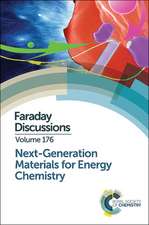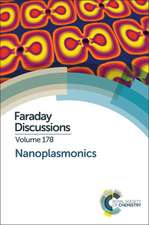Materials for Lithium-Ion Batteries: NATO Science Partnership Subseries: 3, cartea 85
Editat de Christian Julien, Z. Stoynoven Limba Engleză Hardback – 31 oct 2000
Readership: Research students and engineers seeking an expert review. Graduate courses in electrical drives can also be designed around the book by selecting sections for discussion. The coverage and treatment make the book indispensable for the lithium battery community.
| Toate formatele și edițiile | Preț | Express |
|---|---|---|
| Paperback (1) | 1832.70 lei 6-8 săpt. | |
| SPRINGER NETHERLANDS – 31 oct 2000 | 1832.70 lei 6-8 săpt. | |
| Hardback (1) | 1839.17 lei 6-8 săpt. | |
| SPRINGER NETHERLANDS – 31 oct 2000 | 1839.17 lei 6-8 săpt. |
Din seria NATO Science Partnership Subseries: 3
- 24%
 Preț: 1567.22 lei
Preț: 1567.22 lei - 18%
 Preț: 1992.08 lei
Preț: 1992.08 lei -
 Preț: 393.13 lei
Preț: 393.13 lei -
 Preț: 390.63 lei
Preț: 390.63 lei - 18%
 Preț: 1849.41 lei
Preț: 1849.41 lei -
 Preț: 407.19 lei
Preț: 407.19 lei - 18%
 Preț: 1228.96 lei
Preț: 1228.96 lei - 18%
 Preț: 1843.73 lei
Preț: 1843.73 lei - 15%
 Preț: 642.51 lei
Preț: 642.51 lei -
 Preț: 402.76 lei
Preț: 402.76 lei - 18%
 Preț: 1829.86 lei
Preț: 1829.86 lei -
 Preț: 379.48 lei
Preț: 379.48 lei - 18%
 Preț: 1224.54 lei
Preț: 1224.54 lei -
 Preț: 401.42 lei
Preț: 401.42 lei - 18%
 Preț: 1841.68 lei
Preț: 1841.68 lei -
 Preț: 391.99 lei
Preț: 391.99 lei - 18%
 Preț: 1234.46 lei
Preț: 1234.46 lei -
 Preț: 405.28 lei
Preț: 405.28 lei -
 Preț: 396.62 lei
Preț: 396.62 lei - 18%
 Preț: 1226.73 lei
Preț: 1226.73 lei - 18%
 Preț: 1233.52 lei
Preț: 1233.52 lei - 18%
 Preț: 1228.62 lei
Preț: 1228.62 lei - 5%
 Preț: 377.52 lei
Preț: 377.52 lei - 18%
 Preț: 1830.49 lei
Preț: 1830.49 lei - 20%
 Preț: 336.21 lei
Preț: 336.21 lei - 18%
 Preț: 1225.48 lei
Preț: 1225.48 lei -
 Preț: 397.38 lei
Preț: 397.38 lei - 18%
 Preț: 1830.65 lei
Preț: 1830.65 lei - 15%
 Preț: 650.55 lei
Preț: 650.55 lei - 5%
 Preț: 1416.66 lei
Preț: 1416.66 lei
Preț: 1839.17 lei
Preț vechi: 2242.89 lei
-18% Nou
Puncte Express: 2759
Preț estimativ în valută:
351.94€ • 376.33$ • 293.43£
351.94€ • 376.33$ • 293.43£
Carte tipărită la comandă
Livrare economică 17 aprilie-01 mai
Preluare comenzi: 021 569.72.76
Specificații
ISBN-13: 9780792366508
ISBN-10: 0792366506
Pagini: 639
Ilustrații: XIII, 639 p.
Dimensiuni: 155 x 235 x 35 mm
Greutate: 1.09 kg
Ediția:2000
Editura: SPRINGER NETHERLANDS
Colecția Springer
Seria NATO Science Partnership Subseries: 3
Locul publicării:Dordrecht, Netherlands
ISBN-10: 0792366506
Pagini: 639
Ilustrații: XIII, 639 p.
Dimensiuni: 155 x 235 x 35 mm
Greutate: 1.09 kg
Ediția:2000
Editura: SPRINGER NETHERLANDS
Colecția Springer
Seria NATO Science Partnership Subseries: 3
Locul publicării:Dordrecht, Netherlands
Public țintă
ResearchCuprins
1: Lectures.- Design considerations for lithium batteries.- Principles determining the potentials and capacities of electrochemical cells.- Binary electrodes under equilibrium or near-equilibrium conditions.- Better electrode materials for energy storage applications through chemistry.- Carbon-lithium negative electrode for lithium ion batteries: main characteristics and features.- Reactivity and safety aspects of carbonaceous anodes used in lithium-ion batteries. Correlation of structural parameters and reactivity.- Structure and electrochemistry of new lithium intercalation compounds prepared via low temperature techniques.- Structure and electrochemistry of doped LiMO2 (M=Ni, Co) cathode materials.- New transition metal oxide electrodes for lithium batteries.- Electrochemical features of lithium batteries based on molybdenum-oxide compounds.- EXAFS: a structural probe for cathode materials in lithium ion batteries.- Atomistic computer modelling of oxide cathode materials for lithium ion batteries.- Local environment in 4-volt cathode materials for Li-ion batteries.- Raman spectra of anode and cathode materials.- Advanced impedance techniques for lithium batteries study. Part I: experimental setup.- Advanced impedance techniques for lithium batteries study. Part II: data processing.- Advanced impedance techniques for lithium batteries study. Part III: four dimensional analysis.- Advanced impedance techniques for lithium batteries study. Part IV: differential impedance analysis.- Lithium microbatteries.- Fundamental aspects of electrochemical, chemical and electrostatic potentials in lithium batteries.- Chemical stability aspects of high performance lithium batteries.- Kinetic aspects of high performance solid electrolytes and electrodes.- Solid state electrochemical methods for the characterization of the kinetics, thermodynamics and phase equilibria of lithium battery materials.- 2: Seminars.- LiNi(M)O2 layered oxides: positive electrode materials for lithium batteries.- New generation of 3-volt lithiated manganese oxide for high-performance lithium batteries.- Sol-gel synthesis and electrochemical characterization of polycrystalline powders and thin films of Li1+xV3O8.- Microstructure of Li1+xMn2-xO4 cathode materials monitored by EPR of Mn4+.- EPR studies on the microstructure of LiNi1-yCoyO2 electrode materials for lithium-ion batteries.- Mechanochemical synthesis of cathode materials for lithium batteries.- Electronic transport properties in LixCr0.11V2O5.16.- 7Li NMR in some lithium intercalation compounds Taking advantage of electronic spins.- Single conductive polymer electrolytes: from pressure conductivity measurements to transport mechanism.- Electrochemical and structural characterisation near the NiO2 composition.- Synthesis of overlithiated LiNiO2 cathode materials for Li-ion cells.- Differential capacity analysis, a tool to examine the performance of graphites for Li-ion cells.- 3: Posters.- Physico-chemical properties of LiMn2O4 films grown by laser ablation.- ESR studies of cathode materials with spinel structure.- LiNi1-yCoyO2 cathode materials synthesized by wet chemistry.- Comparative study between 4-V LiMn2O4, LiCoO2 and 3-V Li0.3MnO2, LiV3O8 as cathode materials for Li batteries.- Comparative study of the electrochemical behaviour of lithium and potassium vanadates treated by water molecules.- PTFE-acetylene black and ultrafine carbon suspensions as a conductive binder and conductive additive for the positive electrodes of the lithium and Li-ion batteries.- Electrolytes for lithium batteries on the basis of complex fluorides and aprotic media.- Lithium insertion mechanism in copper indium tin sulfospinels studied by 119Sn Mössbauer spectroscopy and Rietveld analysis.- Lithium insertion mechanism in tin oxides: anode materials for lithium-ion batteries.- Characterization of nanostructure tin alloys as anodes in lithium-ion batteries.- Mechanical activation of V2O5 in different media: ethanol, water and air.- ?-MnO2 compounds as insertion hosts for Li+ and H+.- Morphology and electrochemical performance in graphite.- Impedance of lithium ion batteries. Basic models and differential analysis.- New polymer membrane-separation materials for lithium batteries.- Amorphous carbon films: magnetron sputter deposition and Li-intercalation properties.- Transport properties of composite superionic material LiIO3+SiO2.- Magnetron sputtered CuInSe2 layers as materials for solid-state batteries.- Electron-gun evaporated carbon films for Li-ion microbatteries.- Comparison study of the physical characteristics and cycling performance of commercially available Li-ion batteries.- Synthesis, properties and applications of Li-containing nanoparticles as electrode materials.- PMMA based gel polymer electrolytes.- Dielectric relaxations in lithium composite polymer electrolytes based on PEO and diethylaluminum carboxylate.- Author index.





















